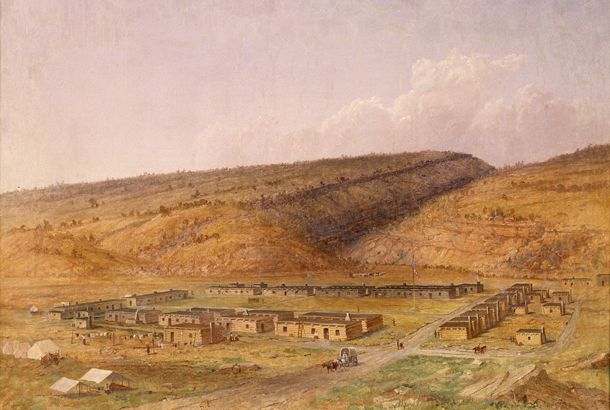
| Title | Fort Defiance, New Mexico (now Arizona) |
| Artist/Maker | Seth Eastman ( 1808 - 1875 ) |
| Date | 1873 |
| Medium | Oil on canvas |
| Dimensions | Sight: h. 21.625 x w. 31.5 in. (h. 54.9275 x w. 80.01 cm)
Framed: h. 34.63 x w. 44.5 in. (h. 87.9602 x w. 113.03 cm) |
| Credit Line | U.S. Senate Collection |
| Accession Number | 33.00011.000 |
Of Seth Eastman’s fort series, this is the only painting of an army post in the Southwest. Located at Canyon Bonito about seven miles north of Window Rock, Arizona, Fort Defiance was established in 1851 to create a military presence in Navajo Country. It was built on valuable grazing land that the federal government then prohibited the Navajo from using. As a result, the appropriately named fort experienced intense fighting, culminating in an unsuccessful 1860 attack by the Navajo. The next year, at the onset of the Civil War, the army abandoned Fort Defiance. Continued Navajo raids in the area led the army to send Kit Carson to impose order. His “solution” was brutal: thousands of starving Navajo were interned in Fort Sumner, New Mexico, and much of their livestock was destroyed. The Navajo Treaty of 1868 allowed those interned to return to a portion of their land, and Fort Defiance was reestablished as an Indian agency that year. It was during the development of the fort into an agency that Eastman depicted the site in his painting, but the evidence of the picture suggests that he never visited the post.
At the base of a butte, a small, rudimentary block of one-story log and sod buildings stands on a foreground plain. A dark gorge divides the butte, and a road emerges from it. In contrast to the lush, grassy grazing land that typified Fort Defiance, in the painting everything is barren and inhospitable. The land is the color of sandalwood, and there is little contrast in the sky. It is tempting to enumerate the buildings because they are the focus of the scene. Low barracks fill most of the small space, but one may discern kitchens, latrines, open tents, distant cattle, wagons, and about 30 human figures, including a group of soldiers drilling in the yard.
The scene is prosaic and matter-of-fact, and this is probably why it seems to embody the true sense of an outpost. Surprisingly, the feeling is similar to that captured by some 20th-century films–-the bleak setting of the Western genre, but without the Native American and army conflict. The decision to omit all battles from Eastman’s series of fort paintings explains this departure from the bitter reality of life at Fort Defiance.